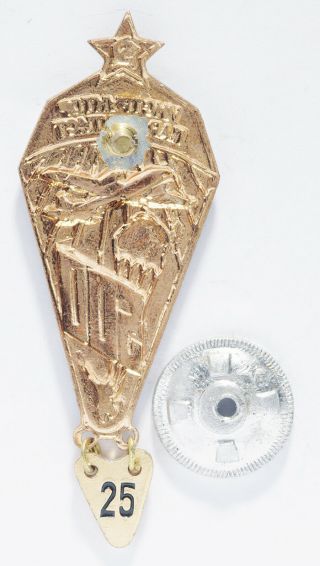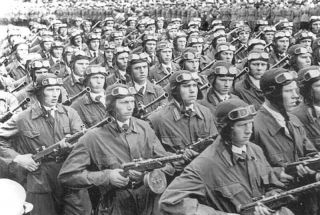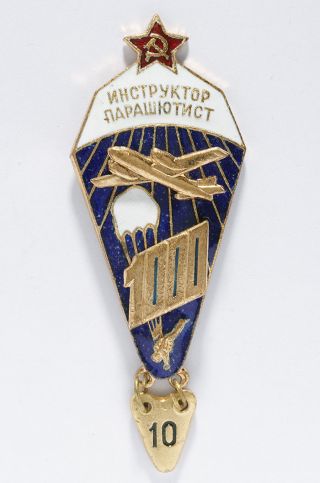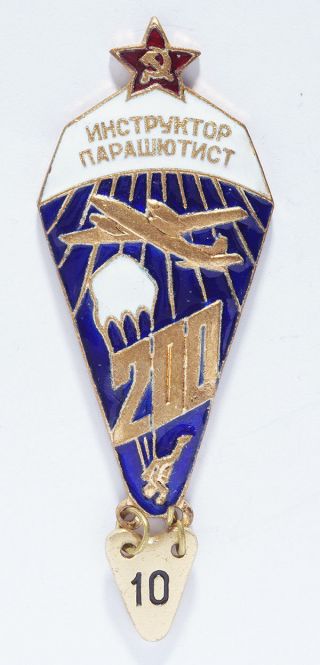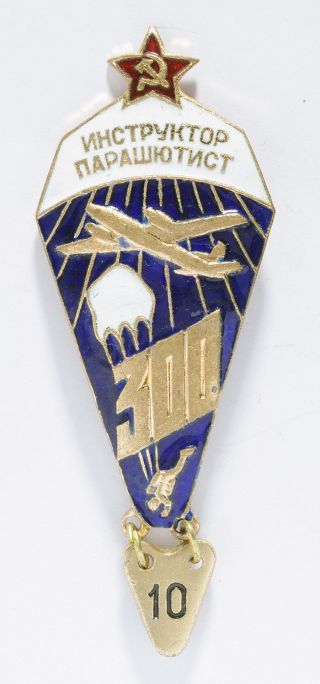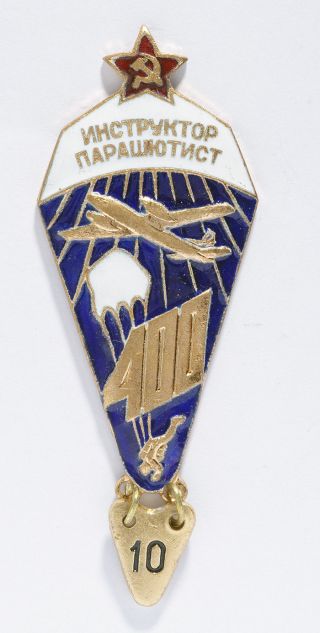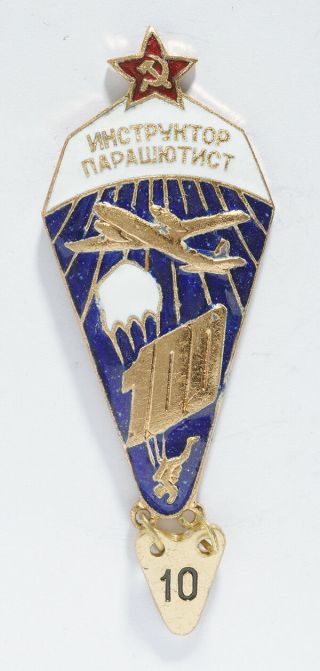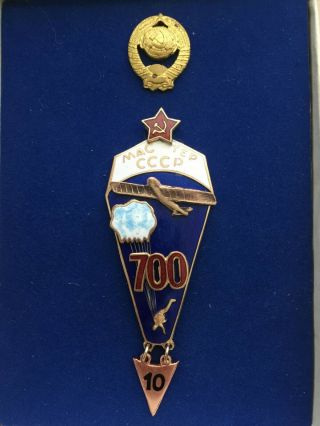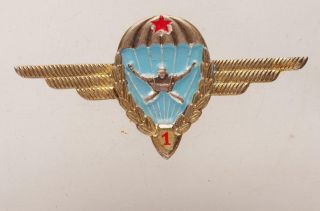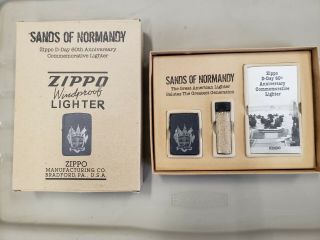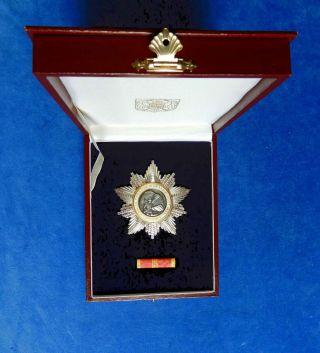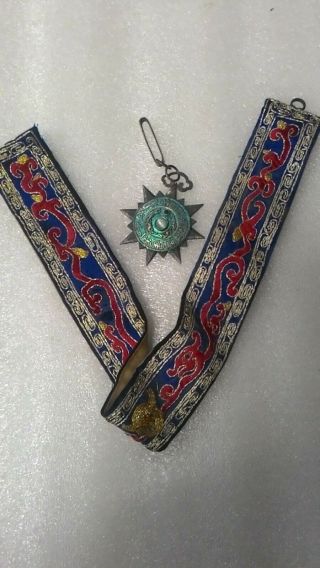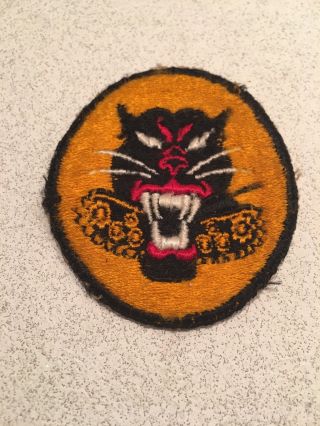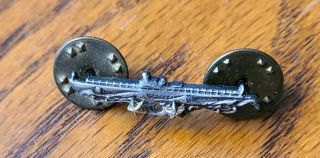Soviet Russian Airborne Parachute Badge Instructor 500 Jumps_ORIGINAL USSR
Item History & Price
Heavy badge, made of quality brass, hot enamel. Original Soviet period badge, from the Cold War period. It made by the famous factory "Pobeda"("Победа"), the leading manufacturer of Soviet military badges. The logo of the factory is visible on the nut. New, not worn.
Only a badge is for sale. The photos are for illustration only.<...br>Russian(Soviet) Airborne Troops.
The Russian Airborne Troops or VDV (from "Vozdushno-desantnye voyska Rossii", Russian: Воздушно-десантные войска России, ВДВ; Air-landing Forces) is a military branch of the Armed Forces of the Russian Federation. First formed before World War II, the force undertook two significant airborne operations and a number of smaller jumps during the war and for many years after 1945 was the largest airborne force in the world. The force was split after the dissolution of the Soviet Union, losing divisions to Belarus and Ukraine, and has been reduced in size.
Russian airborne forces have traditionally worn a blue beret and blue-striped telnyashka and are called "desant" (Russian: Десант) from the French "Descente".
Interwar and World War II The first airborne forces parachute jump is dated to 2 August 1930, taking place in the Moscow Military District. Airborne landing detachments were established after the initial 1930 experimental jump, but creation of larger units had to wait until 1932–33. On 11 December 1932, a Revolutionary Military Council order established an airborne brigade from the existing detachment in the Leningrad Military District.To implement the order, a directive of the Commissariat of Military and Naval Affairs transformed the Leningrad Military District’s 3rd Motorised Airborne Landing Detachment into the 3rd Airborne Brigade (Special Purpose) commanded by M.V. Boytsov. Two further airborne brigades (the 13th and 47th) and three airborne regiments (the 1st, 2nd, and 5th, all in the Far East) were created in 1936. In March and April 1941, five Airborne Corps (divisions) were established on the basis of the existing 201st, 204th, 211th, 212th, and 214th Airborne Brigades. The number of Airborne Corps rose from five to ten in late 1941, but then all the airborne corps were converted into "Guards" Rifle Divisions in the northern hemisphere summer of 1942.
The Soviet airborne forces were mostly used as 'foot' infantry during the war. Only a few small airborne drops were carried out in the first desperate days of Operation Barbarossa, in the vicinity of Kiev, Odessa, and the Kerch peninsula. The two significant airborne operations of the war were the Vyazma operation of February–March 1942, involving 4th Airborne Corps, and the Dnepr/Kiev operation of September 1943, involving a temporary corps formation consisting of 1st, 3rd, and 5th Airborne Brigades. Glantz writes: "After the extensive airborne activity during the winter campaign of 1941–42, airborne forces underwent another major reorganization the following summer. Responding to events in southern Russia, where German troops had opened a major offensive that would culminate in the Stalingrad battles, the ten airborne corps, as part of the Stavka strategic reserves, deployed southward. Furthermore, the Stavka converted all ten airborne corps into guards rifle divisions to bolster Soviet forces in the south. Nine of these divisions participated in the battles around Stalingrad, and one took part in the defense of the northern Caucasus region."
The Stavka still foresaw the necessity of conducting actual airborne operations later during the war. To have [such a force] the Stavka created eight new airborne corps (1st, 4th, 5th, 6th, 7th, 8th, 9th, and 10th) in the fall of 1942. Beginning in December 1942, these corps became ten guards airborne divisions (numbered 1st, 2nd, 3rd, 4th, 5th (formed from 9th Airborne Corps (2nd formation)), 6th, 7th, 8th, 9th, 10th, two formed from the 1st Airborne Corps and the three existing separate maneuver airborne brigades). The new guards airborne divisions trained in airborne techniques, and all personnel jumped three to ten times during training, though many were from jump towers.
After the defeat of German forces at Kursk, the bulk of the airborne divisions joined in the pursuit of German forces to the Dnepr River. Even as ten guards airborne divisions fought at the front, new airborne brigades formed in the rear areas. In April and May 1943, twenty brigades formed and trained for future airborne operations. Most of these brigades had become six new guards airborne divisions (11th through 16th) by September 1943. The Stavka however, earmarked three of these airborne brigades for use in an airborne operation to cross the Dnepr River, which was unsuccessful.
David Glantz wrote in 1984:
In August [1944], the Stavka formed the 37th, 38th, and 39th Guards Airborne Corps. By October, the newly formed corps had combined into a separate airborne army under Maj. Gen. I. I. Zatevakhin. However, because of the growing need for well-trained ground units, the new army did not endure long as an airborne unit. In December, separate airborne army the Stavka reorganized the separate airborne army into the 9th Guards Army of Col. Gen. V. V. Glagolev, and all divisions were renumbered as guards rifle divisions. As testimony to the elite nature of airborne-trained units, the Stavka held the 9th Guards Army out of defensive actions, using it only for exploitation during offensives.
From 1944 the airborne divisions were reconstituted as Guards Rifle Divisions.
During the invasion of Manchuria and South Sakhalin Operation, airborne units were used to seize airfields and city centers in advance of the land forces, and to ferry fuel to those units that had outrun their supply lines
Postwar
HQ 9th Guards Army was redesignated Headquarters Airborne Forces in June 1946 after the war ended.The units of the Army were removed from the order of battle of the Air Forces of USSR and assigned directly to the Ministry of Armed Forces of USSR.
In 1946 the force consisted of five corps (the 8th and 15th had been added) and ten divisions:
8th Guards Airborne Corps (103rd and 114th Divisions). The 114th Guards Airborne Division was established in 1946 on the basis of the similarly numbered Rifle Division in Borovukha (just east of Slutsk) in the Belarussian SSR. The Division was disbanded in 1956, with two of its regiments (the 350th and 357th) joining the 103rd Guards Airborne Division.15th Guards Airborne Corps (the 76th and 104th Divisions at Pskov), 37th Guards Airborne Corps (the 98th and 99th in Primorsky Krai)38th Guards Airborne Corps (105th and 106th at Tula), 39th Guards Airborne Corps at Belaya Tserkov in Ukraine (the 100th and 107th Guards Airborne Divisions (Chernigov, disbanded 1959))In the summer of 1948, five more Guards Airborne Divisions were created. The 7th (Lithuania, 8th Airborne Corps), the 11th (activated 1 October 1948 in Ryazan, Moscow Oblast, from the 347th Guards Air Landing Regiment, 38th Airborne Corps), the 13th Guards (at Galenki, Primorskiy Kray, with the 37th Airborne Corps), the 21st Guards (Estonia, Valga, with the 15th Airborne Corps), and the 31st Guards (Carpathians, 39th Airborne Corps). At the end of 1955 and the beginning of 1956 the 11th Guards, 21st, 100th and 114th Guards Airborne Divisions were disbanded as well as all the airborne corps headquarters. The number of divisions, thus, decreased to 11. In April 1955 the transport aircraft were separated from the VDV and the Air Force Military Transport Aviation was created. In 1959 the 31st and 107th Guards Airborne Divisions were disbanded, but in October 1960 the 44th Training Airborne Division was formed. In 1964 the Airborne Forces were directly subordinated to the Ministry of Defence.
The creation of the post-war Soviet Airborne Forces owe much to the efforts of one man, Army General Vasily Margelov, so much so that the abbreviation of VDV in the Airborne Forces is sometimes waggishly interpreted as "Войска дяди Васи", "Uncle Vasya's Troops".
Airborne units of two divisions (7th and 31st Guards) were used during Soviet operations in Hungary during 1956, and the 7th Guards division was used again during the 1968 Operation Danube invasion of Czechoslovakia. The first experimental air assault brigade – the 1st Airborne [Airmobile/Air Assault] Brigade – was apparently activated in 1967/1968 from parts of the 51st Guards Parachute Landing Regiment (PDP) (Tula), after the Soviets had been impressed by the American experiences in Vietnam. In 1973 the 13th and 99th Airborne Divisions were reorganised as air assault brigades, and thus the number of divisions dropped to eight.[19] There were also independent regiments and battalions. However, even by the 1980s only two divisions were capable of being deployed for combat operations in the first wave against NATO using Air Force Military Transport Aviation and Aeroflot aircraft.
Airborne Troops Commander-in-Chief Vasily Margelov had continued to wear the Telnyashka blue-and-white striped shirt commemorating an earlier moment in his career, from his wartime Naval Infantry service in the Baltic Fleet. In 1979, the telnyashka became an official part of the uniform.
In accordance with a directive of the General Staff, from August 3, 1979, to December 1, 1979, the 105th Guards Vienna Airborne Division was disbanded.[26] From the division remained in the city of Fergana the 345th Independent Guards Airborne Regiment (much stronger than the usual regimental size) with the separate 115th military-transport aviation squadron. The rest of the personnel of the division were reassigned to fill out other incomplete airborne units and formations and to the newly formed air assault brigades. Based on the division's 351st Guards Parachute Regiment, the 56th Guards Separate Air Assault Brigade was formed in Azadbash, (Chirchiq district) Tashkent Oblast, Uzbek SSR. Meanwhile, the 111th Guards Parachute Regiment became the 35th Separate Guards Air Assault Brigade.
However, there was also a mistaken Western belief, either intentional Soviet deception or stemming from confusion in the West, that an Airborne Division, reported as the 6th, was being maintained at Belogorsk in the Far East in the 1980s This maskirovka division was then 'disbanded' later in the 1980s, causing comment within Western professional journals that another division was likely to be reformed so that the Far East had an airborne presence. The division was not listed in V.I. Feskov et al.'s The Soviet Army during the period of the Cold War, (2004) and the division at Belogorsk, the 98th Guards Airborne Svirskaya Red Banner Order of Kutuzov Division moved to Bolgrad in the Ukraine in late 1969.
The 103rd Guards Airborne Division, 345th Independent Guards Airborne Regiment and the 56th Air Assault Brigade fought in the Soviet–Afghan War.
In 1989, the Airborne Forces consisted of:
7th Guards Cherkassy Airborne Division (HQ Kaunas Fortress, Lithuanian SSR)76th Guards Chernigov Airborne Division (Pskov, RSFSR)98th Guards Svir Airborne Division (Bolgrad & Kishinev, Moldovan SSR)103rd Guards Airborne Division (Vitebsk, Belorussian SSR)104th Guards Airborne Division (Kirovabad, Azerbaijan SSR)106th Guards Airborne Division (Tula, RSFSR)242nd District Training Centre of the Airborne Forces (Gaižiūnai/Jonava, Lithuanian SSR) created from the 44th Training Airborne Division. However, the divisional banner was retained. The division was established in Ostrov in September 1960 as the 44th Training Airborne Division. In September 1961 it was transferred to the Lithuanian SSR.345th Independent Guards Airborne Regiment (Gudauta, Georgian SSR)171st Independent Communications Brigade (Medvezhi Ozera, Moscow Military District, RSFSR)Air assault units of the Ground ForcesFrom the late 1970s to the 1980s, 13 separate air assault brigades were activated. These brigades provided airmobile capability for military districts and groups of forces. In 1989, these brigades transferred to control of the VDV. During the same period, 19 separate air assault battalions were activated. These battalions originally provided airmobile capability to armies and other formations but were mostly disbanded in 1989.
In 1979, the 58th Air Assault Brigade was activated as a mobilization unit in Kremenchug. It was co-located with the 23rd Air Assault Brigade from 1986 and disbanded in 1989. The 128th Air Assault Brigade existed between 1986 and 1989 as a mobilization unit in Stavropol. The 130th Air Assault Brigade existed between 1986 and 1989 as a mobilization unit in Abakan.




